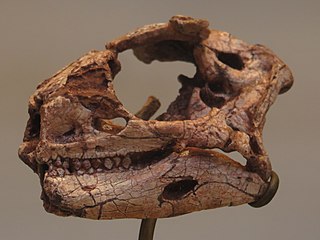
Lesothosaurus is a monospecific genus of ornithischian dinosaur that lived during the Early Jurassic in what is now South Africa and Lesotho. It was named by paleontologist Peter Galton in 1978, the name meaning "lizard from Lesotho". The genus has only one valid species, Lesothosaurus diagnosticus. Lesothosaurus is one of the most completely-known early ornithischians, based on numerous skull and postcranial fossils from the Upper Elliot Formation. It had a simpler tooth and jaw anatomy than later ornithischians, and may have been omnivorous in some parts of the year.
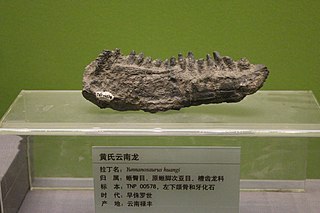
Yunnanosaurus is an extinct genus of sauropodomorph dinosaur that lived approximately 199 to 183 million years ago in what is now the Yunnan Province, in China, for which it was named. Yunnanosaurus was a large sized, moderately-built, ground-dwelling, quadrupedal herbivore, that could also walk bipedally, and ranged in size from 7 meters (23 feet) long and 2 m (6.5 ft) high to 4 m (13 ft) high in the largest species.
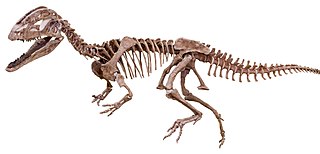
Sinosaurus is an extinct genus of theropod dinosaur which lived during the Early Jurassic Period. It was a bipedal carnivore approximately 5.5 metres (18 ft) in length and 300 kilograms (660 lb) in body mass. Fossils of the animal were found at the Lufeng Formation, in the Yunnan Province of China.

Chindesaurus is an extinct genus of basal saurischian dinosaur from the Late Triassic of the southwestern United States. It is known from a single species, C. bryansmalli, based on a partial skeleton recovered from Petrified Forest National Park in Arizona. The original specimen was nicknamed "Gertie", and generated much publicity for the park upon its discovery in 1984 and airlift out of the park in 1985. Other fragmentary referred specimens have been found in Late Triassic sediments throughout Arizona, New Mexico, and Texas, but these may not belong to the genus. Chindesaurus was a bipedal carnivore, approximately as large as a wolf.
Angelosaurus is an extinct genus of herbivorous caseid synapsids that lived during the late Lower Permian (Kungurian) and early Middle Permian (Roadian) in what is now Texas and Oklahoma in the United States. Like other herbivorous caseids, it had a small head, large barrel-shaped body, long tail, and massive limbs. Angelosaurus differs from other caseids by the extreme massiveness of its bones, particularly those of the limbs, which show a strong development of ridges, processes, and rugosities for the attachment of muscles and tendons. Relative to its body size, the limbs of Angelosaurus were shorter and wider than those of other caseids. The ungual phalanges looked more like hooves than claws. The few known cranial elements show that the skull was short and more robust than that of the other representatives of the group. Angelosaurus is also distinguished by its bulbous teeth with shorter and wider crowns than those of other caseids. Their morphology and the high rate of wear they exhibit suggests a diet quite different from that of other large herbivorous caseids, and must have been based on particularly tough plants. A study published in 2022 suggests that the genus may be paraphyletic, with Angelosaurus possibly only represented by its type species A. dolani.

Mandasuchus is an extinct genus of loricatan pseudosuchian from the Manda Formation of Tanzania, which dates back to the Anisian stage of the Middle Triassic. Although this genus was first mentioned by Alan Charig in 1956, a formal description was not published until 2018.

Platyognathus is an extinct genus of protosuchian crocodylomorph. Fossils are known from the Early Jurassic Lower Lufeng Formation in Yunnan, China and belong to the type and only species, P. hsui.

Fodonyx is an extinct genus of rhynchosaur from the middle Triassic epoch of Devon in England. Its fossils were discovered in Otter Sandstone Formation and were first assigned to Rhynchosaurus spenceri. This species was reassigned to its own genus, Fodonyx the holotype of which is EXEMS 60/1985/292, that described by David W. E. Hone and Michael J. Benton in 2008. More recently, one skull was reassigned to the new genus Bentonyx. It is distinguished from other rhynchosaurs by a single autapomorphy, the ventral angling of the paraoccipital processes. In all other rhynchosaurs these processes angle dorsally or are horizontal. It is not known if this conferred any advantage to Fodonyx. Fodonyx was between 40 and 50 cm long.
Dianopachysaurus is an extinct genus of pachypleurosaur known from the lower Middle Triassic of Yunnan Province, southwestern China. It was found in the Middle Triassic Lagerstätte of the Guanling Formation. It was first named by Jun Liu, Olivier Rieppel, Da-Yong Jiang, Jonathan C. Aitchison, Ryosuke Motani, Qi-Yue Zhang, Chang-Yong Zhou and Yuan-Yuan Sun in 2011 and the type species is Dianopachysaurus dingi, thanking a Professor Ding for his help.

Sinosaurosphargis is an extinct genus of basal marine saurosphargid reptile known from the Middle Triassic Guanling Formation of Yunnan and Guizhou Provinces, southwestern China. It contains a single species, Sinosaurosphargis yunguiensis.
Xilousuchus is an extinct genus of poposauroid from lower Triassic deposits of Fugu County of northeastern Shanxi Province, China. It is known from the holotype, IVPP V 6026, a single well-preserved partial skeleton including the skull. It was found from the Heshanggou Formation of the Ordos Basin, Hazhen commune. It was first named by Xiao-Chun Wu in 1981 and the type species is Xilousuchus sapingensis. Wu (1981) referred Xilousuchus to the Proterosuchia. Gower and Sennikov (1996) found it to be an erythrosuchian based strictly on the braincase. A more detailed re-description of the genus was provided by Nesbitt et al. (2010) and found poposauroid affinities. In his massive revision of archosaurs which included a large cladistic analysis, Sterling J. Nesbitt (2011) found Xilousuchus to be a poposauroid which is most closely related to Arizonasaurus. Xilousuchus is the oldest archosaur to date, although Ctenosauriscus and Vytshegdosuchus might be even older by less than one million year. Since Xilousuchus is a suchian archosaur, its early age suggests that most of the major groups of archosaurs developed by the Early Triassic, soon after the appearance of the first archosaur.
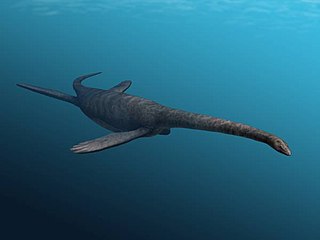
Yunguisaurus is an extinct genus of pistosaur known from the Guizhou Province of China.
Qianxisaurus is an extinct genus of pachypleurosaur or alternatively a basal eosauropterygian known from the Middle Triassic of Guizhou Province, southwestern China. It contains a single species, Qianxisaurus chajiangensis.
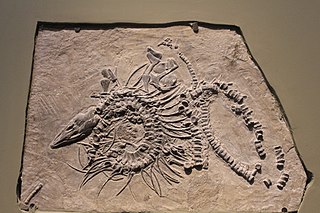
Xinpusaurus is an extinct genus of thalattosaur from the Late Triassic of Guanling in Guizhou, China. Several species have been named since 2000: the type species X. suni along with the species X. bamaolinensis and X. kohi. A 2013 study proposed that all three species are synonymous with each other, in which case X. suni would be the only valid species, although a 2014 study argued that X. kohi was also valid. A fourth species, X. xingyiensis, was described in 2016.
Xinminosaurus is an extinct genus of cymbospondylid ichthyosaur known from the Middle Triassic of Guizhou Province, China.
Fuyuansaurus is an extinct genus of "protorosaur" reptiles known from the Middle Triassic Zhuganpo Formation of southern China. Fuyuansaurus was first named by Nicholas C. Fraser, Olivier Rieppel and Li Chun in 2013 and the type species is Fuyuansaurus acutirostris.
Sanchiaosaurus is an extinct genus of a basal nothosauroid known from the Middle Triassic of Guizhou Province, southwestern China. It contains a single species, Sanchiaosaurus dengi.
Kwangsisaurus is an extinct genus of a basal pistosauroid known from the Early or Middle Triassic of Guangxi, southern China. It contains a single species, Kwangsisaurus orientalis.

Cricodon is an extinct genus of trirachodontid cynodonts that lived during the Early Triassic and Middle Triassic periods of Africa. A. W. Crompton named Cricodon based on the ring-like arrangement of the cuspules on the crown of a typical postcanine tooth. The epithet of the type species, C. metabolus, indicates the change in structure of certain postcanines resulting from replacement.

Zhongjianosaurus is a genus of dromaeosaurid belonging to the Microraptoria. Believed to hail from the Yixian Formation, specifically the middle of the Jehol Biota, it is the smallest known microraptorine thus far discovered and one of the smallest non-avian theropod dinosaurs.


















